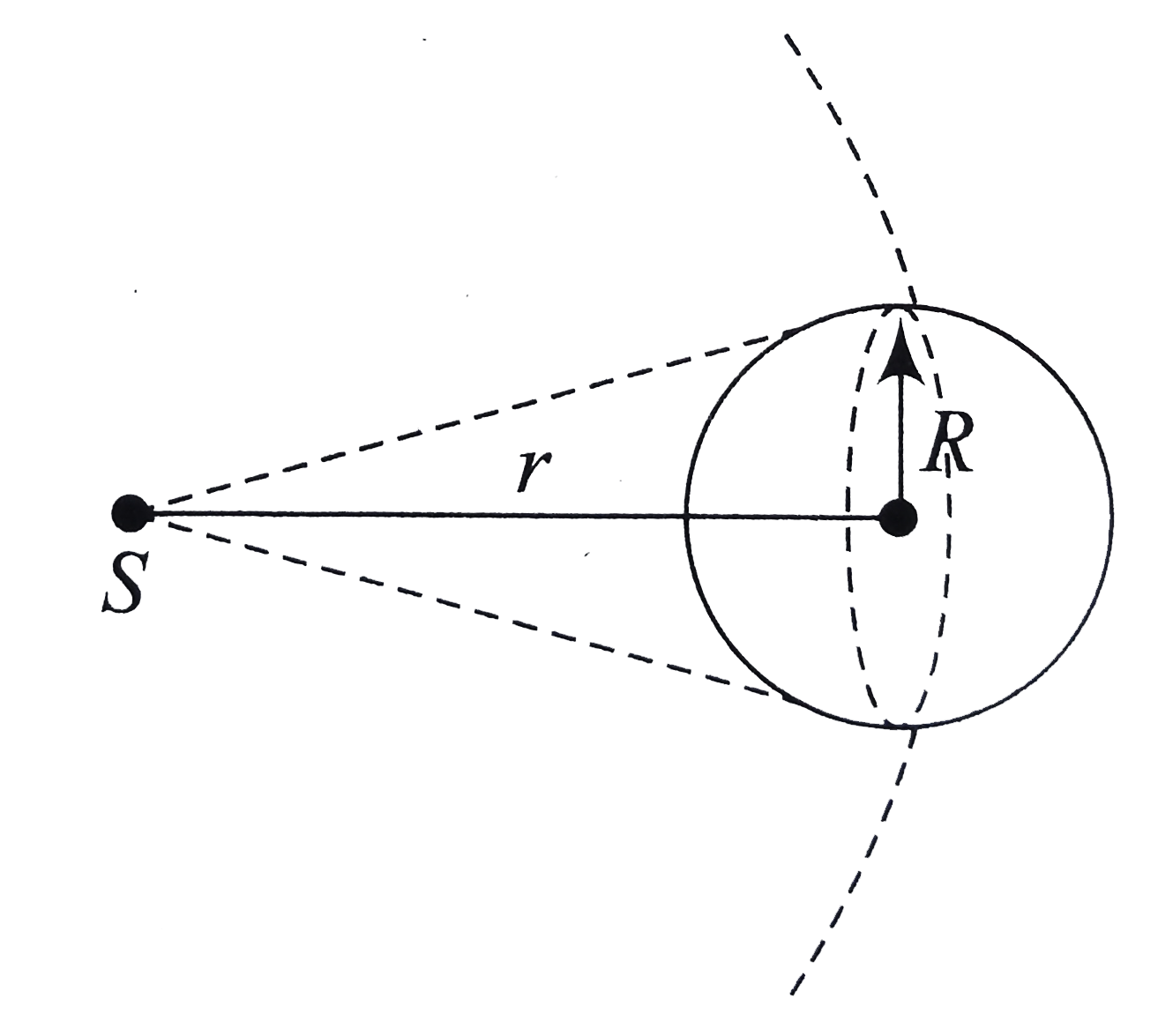in an experimental set up to study the photoelectric effect a point source of light of power 3.2×10−3 W was taken. The source can emit mono energetic photons of energy 5eV and is located at a distance of 0.8 m from the center of a stationary metallic sphere of work-function 3.0 eV. The radius of the sphere is r=8×10−3 m. The efficiency of photoelectric emission is one for every 106 incident photons. Based on the information given above answer the questions given below. (Assume that the sphere is isolated and photoelectrons are instantly swept away after the emission).
Time after which photoelectric emission stops is
103
104
5×104
105
The correct Answer is:D

If P is the power of point source of light, the intensity at a distance r is
I=P4πr2
The energy intercepted by themetallic sphere is
E= intensity × projected area of sphere =P4πr2×πR2
If e is the energy of the single photon and η the efficiency of the photon to liberate an electron, the number of ejected electrons is ηPR24r2r=(10−6)(3.2×10−3)(8×10−3)24×(0.8)×(5×1.6×10−19)
=105 electron s−1
The emission of electrons from a metallic sphere leaves it positively charged. As the potential of the charged sphere begins to rise, it attracts emitted electron. The emission of electrons will stop when the kinetic energy of the electrons if neutralised by the retarding potential of the sphere. So, we have
eV=(KEmax
V=(KEmaxe)
From Einstein's photoelectric equation,
KEmax=hv−ϕ=(5−3)=2eV The potential of a charged sphere is
V=14πε0qR=14πε0(neR)
14πε0(neR)=2
n=4πε02Re
2×8×10−39×109×1.6×10−19=1.11×107
The photoelectric effect will stop when 1.11×107 electrons have been emitted. The time taken by it to emit 1.11×107 electrons,
t=1.11×107105=111s=1.85 min
Topper's Solved these Questions
- PHOTOELECTRIC EFFECTBOOK - CENGAGE PHYSICS ENGLISHCHAPTER - PHOTOELECTRIC EFFECTEXERCISE - Integer
9 Videos
- PHOTOELECTRIC EFFECTBOOK - CENGAGE PHYSICS ENGLISHCHAPTER - PHOTOELECTRIC EFFECTEXERCISE - Single Correct Answer Type
7 Videos
- PHOTOELECTRIC EFFECTBOOK - CENGAGE PHYSICS ENGLISHCHAPTER - PHOTOELECTRIC EFFECTEXERCISE - Multiple Correct
10 Videos
- NUCLEAR PHYSICSBOOK - CENGAGE PHYSICS ENGLISHCHAPTER - NUCLEAR PHYSICSEXERCISE - ddp.5.5
14 Videos
- RAY OPTICSBOOK - CENGAGE PHYSICS ENGLISHCHAPTER - RAY OPTICSEXERCISE - DPP 1.6
12 Videos
Similar Questions
in an experimental set up to study the photoelectric effect a point soure fo light of power 3.2×10−3 W was taken. The source can emit monoenergetic photons of energy 5eV and is located at a distance of 0.8 m from the centre of a stationary metallic sphere of work-function 3.0 eV. The radius of the sphere is r=8..10−3 m. The efficiency of photoelectric emission is one for every 106 incident photons. Based on the information given above answer the questions given below. (Assume that the sphere is isolated and photoelectrons are instantly swepts away after the emission).
Time after which photoelectric emission stops is
View Solutionin an experimental set up to study the photoelectric effect a point soure fo light of power 3.2×10−3 W was taken. The source can emit monoenergetic photons of energy 5eV and is located at a distance of 0.8 m from the centre of a stationary metallic sphere of work-function 3.0 eV. The radius of the sphere is r=8..10−3 m. The efficiency of photoelectric emission is one for every 106 incident photons. Based on the information given above answer the questions given below. (Assume that the sphere is isolated and photoelectrons are instantly swepts away after the emission).
de-Broglie wavelength of the fastest moving photoelectron is
View Solutionin an experimental set up to study the photoelectric effect a point soure fo light of power 3.2×10−3 W was taken. The source can emit monoenergetic photons of energy 5eV and is located at a distance of 0.8 m from the centre of a stationary metallic sphere of work-function 3.0 eV. The radius of the sphere is r=8..10−3 m. The efficiency of photoelectric emission is one for every 106 incident photons. Based on the information given above answer the questions given below. (Assume that the sphere is isolated and photoelectrons are instantly swepts away after the emission).
It was observed that after some time emission of photoelectrons from the sphere stopped. Charge on the sphere when the photon emission stops is
View SolutionThe sound intensity is 0.008W/m2 at a distance of 10 m from an isotropic point source of sound. The power of the source is
View SolutionWhen photon of energy 3.8 eV falls on metallic suface of work function 2.8 eV , then the kinetic energy of emitted electrons are
View SolutionA hot metal emits photons of light with energy 3.0×10−19J. Calculate the frequency and wavelength of the photon?
View SolutionA hot metal emits photons of light with energy 3.0×10−19J. Calculate the frequency and wavelength of the photon?
View SolutionA photon of wavelength 4×10−7m strikes on metal surface, The work function of the metal is 2.13eV. The velocity of the photo electron is
View SolutionThe intensity of sound from a point source is 1.0×10−8Wm−2, at a distance of 5.0 m from the source. What will be the intensity at a distance of 25 m from the source ?
View SolutionA light beam consists of two types of photons. In one type, each photon has the energy 2 eV and in another type, each photon has energy 3 eV. The light beam is incident on a photoelectric material of work function 1 eV. The maximum kinetic enregy of emitted photoelectron is
View Solution
